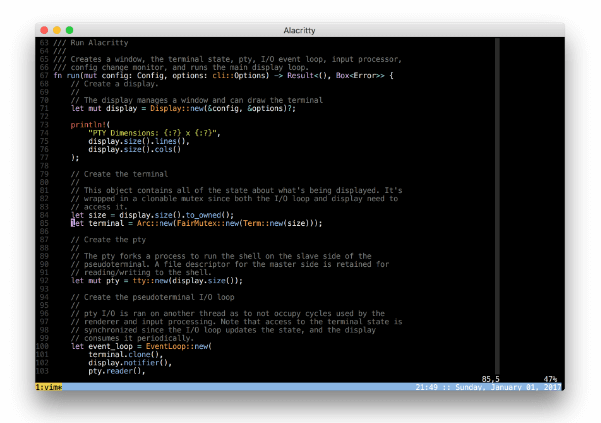- When using Terminal on Mac, it might look like you are trying to hack into a system. While of course, it is not the case, knowing Mac Terminal commands will give you an upper hand in mastering the MacOS environment. As a Terminal emulator, it provides you with text-based access to the operating system.
- SSH or Secure SHell is an encrypted connection protocol which is used to connect to the command line interface of a remote machine. Mac OS features a built-in SSH client called Terminal which allows you to quickly and easily connect to a server.
Mac for architects. Aug 23, 2019 The Terminal in macOS is one handy tool that few people make use of. Here we will show you how you can use the Terminal in macOS to scan your local network for troubleshooting, maintenance and general curiosity. Mozilla for mac os x lion.
| Developer(s) | Apple Inc. |
|---|---|
| Operating system | macOS |
| Platform | ARM64, x86-64, IA-32, PowerPC |
| Type | Terminal emulator |
| Website | www.apple.com/macosx/features/unix/ |
Terminal (Terminal.app) is the terminal emulator included in the macOSoperating system by Apple.[1] Terminal originated in NeXTSTEP and OPENSTEP, the predecessor operating systems of macOS.[2]
As a terminal emulator, the application provides text-based access to the operating system, in contrast to the mostly graphical nature of the user experience of macOS, by providing a command-line interface to the operating system when used in conjunction with a Unix shell, such as zsh (the default shell in macOS Catalina[3]).[4] The user can choose other shells available with macOS, such as the KornShell, tcsh, and bash.[4][5]
The preferences dialog for Terminal.app in OS X 10.8 (Mountain Lion) and later offers choices for values of the TERM environment variable. Available options are ansi, dtterm, nsterm, rxvt, vt52, vt100, vt102, xterm, xterm-16color and xterm-256color, which differ from the OS X 10.5 (Leopard) choices by dropping the xterm-color and adding xterm-16color and xterm-256color. These settings do not alter the operation of Terminal, and the xterm settings do not match the behavior of xterm.[6]
Terminal includes several features that specifically access macOS APIs and features. These include the ability to use the standard macOS Help search function to find manual pages and integration with Spotlight.[citation needed] Terminal was used by Apple as a showcase for macOS graphics APIs in early advertising of Mac OS X,[citation needed] offering a range of custom font and coloring options, including transparent backgrounds.
See also[edit]
- iTerm2, GPL-licensed terminal emulator for macOS
- Terminator, open-source terminal emulator programmed in Java

References[edit]
- ^'What Is Mac OS X - All Applications and Utilities - Terminal'. Apple Inc. Archived from the original on May 10, 2013.
- ^Wünschiers, Röbbe (January 1, 2004). Computational Biology: Unix/Linux, data processing and programming : with 19 figures and 12 tables. Springer Science & Business Media. ISBN9783540211426.
- ^'Use zsh as the default shell on your Mac'. Apple Support. Retrieved January 18, 2020.
- ^ abMcElhearn, Kirk (December 26, 2006). The Mac OS X Command Line: Unix Under the Hood. John Wiley & Sons. ISBN9780470113851.
- ^Kissell, Joe (January 1, 2009). Take Control of the Mac Command Line with Terminal. TidBITS Publishing, Inc. ISBN9781933671550.
- ^'nsterm - AppKit Terminal.app', terminfo.src, retrieved June 7, 2013
| Wikimedia Commons has media related to Terminal (macOS). |
You can search Terminal in Spotlight, or go to the Applications folder, open the Utilities subfolder, and look for the Terminal app.
When you open it, you’ll get this screen - or something really similar: Applications download for mac.
The bash-3.2 indicates the type of shell, and its version. New term here - shell. What is a shell? A shell is a program that allows us to interact with the operating system and its applications.
Note: current macOS since Catalina uses zsh. Nothing else changes related to this tutorial
There are different kinds of shells: Bash is one of the most popular. Some people use Fish (like me), some use Z Shell, some use other ones.
The shell is basically the program that allows us to enter our commands.
Terminal For Mac
File system commands
We can start by entering the ls command, and when we press enter the shell shows us the files contained in the current folder.
The shell normally starts from your home folder, which on a Mac is in /Users/yourname.How do we know in which folder we currently are? You can get it using the pwd command:
Running C Programs Using Terminal Mac Os
You can change the current folder using cd:
If you just type cd, the shell will get back to your home folder.
You can create a new folder using mkdir:
Running commands
In the shell you have access to all the programs and files installed on your computer. A lot of stuff.
One task you might be required to do, especially when programming in Node and JavaScript, is to use npm.
npm is not a command that’s available out of the box, you need to install it from https://www.npmjs.com/get-npm, but when you get it, you can access it from the command line.
Once you do so, you can go into any empty folder and run npm init to initialize a Node.js project.

Once you are ready you can start any Node.js program by running node filename.js.
There’s a lot more to it!
Terminal Macos Theme
This post can get you started quickly to do the job, and you can explore more advanced features and capabilities of the shell later.
